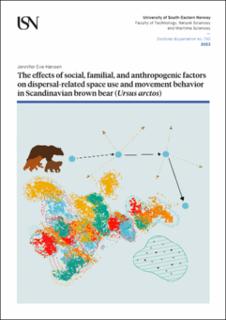| dc.contributor.author | Hansen, Jennifer Eve | |
| dc.date.accessioned | 2023-02-15T12:02:34Z | |
| dc.date.available | 2023-02-15T12:02:34Z | |
| dc.date.issued | 2023-01-19 | |
| dc.identifier.isbn | 978-82-7206-734-1 | |
| dc.identifier.issn | 2535-5252 | |
| dc.identifier.uri | https://hdl.handle.net/11250/3051078 | |
| dc.description.abstract | Among mammals, dispersal is one of the most critical life phases whose outcomes have enormous consequences for survival and reproduction. However, there are several unknowns regarding dispersal and settlement decisions, particularly in elusive, solitary mammals. While the influence of the social environment on dispersal has been relatively well-studied for social species, whether it plays a role for solitary mammals is unclear. Similarly, studies on parent-offspring conflict (POC) and sibling competition (SC) in dispersal typically focus on social or territorial species. There is a need to examine whether the social context of the landscape and familial conflict influence settlement decisions in solitary, non-territorial mammals. In the first two studies in this thesis, we use female brown bears (Ursus arctos) as a model for investigating social and familial factors on settlement decisions in a solitary mammal. In the second study, we take an additional step of determining if where females settle influences their fitness, i.e. in lifetime survival and reproduction. For the third study, we shift focus to habitat selection and movement of male bears in response to anthropogenic features on the landscape. Studies measuring movement and selection for the purposes of generating connectivity maps often use only geolocation data of resident individuals in their analysis. Given that dispersers likely select resources and move in a way different from residents, it is important to include them in selection/movement analyses. Scale of selection has shown to be influential in past selection studies, so we consider also how males in these two life stages select resources in two scales, landscape and local.
Our first study showed evidence of females using cues from the social landscape when making settlement decisions, including settling preferentially where they can overlap their mother and familiar females. They also select settlement ranges with higher density than their natal range, perhaps a form of conspecific attraction. The results indicate solitary mammals may be more socially aware than previously understood. Our second study indicated weak evidence for POC and stronger evidence of SC in female settlement. Female offspring settle closer to the natal range if their mother died prior to settlement and in pairs of female siblings, one settles significantly closer to the natal range. Thus, familial conflict between siblings may be greater than between mother and daughter. We found contradictory results regarding where a female settled and her fitness outcomes. This may be due to high population turnover from the annual harvest. Our third study revealed unique patterns of male resource selection and movement in two life stages. In general, resident males showed clearer patterns of selection and avoidance while dispersers were largely indifferent. However, both life stages showed some avoidance of anthropogenic features on the landscape. Resident males showed some unique patterns in selection in different scales, while dispersers did not. These patterns likely reflect resident males greater experience with the broader landscape and the relative naivety of dispersers. Connectivity studies would therefor benefit from including dispersing individuals when generating least-cost pathways and resistance surfaces. | en_US |
| dc.language.iso | eng | en_US |
| dc.publisher | University of South-Eastern Norway | en_US |
| dc.relation.ispartofseries | Doctoral dissertations at the University of South-Eastern Norway;150 | |
| dc.relation.haspart | Article 1: Hansen, J.E., Hertel, A.G., Frank, S.C., Kindberg, J. & Zedrosser, A.: Social environment shapes female settlement decisions in a solitary carnivore. Behavioral Ecology 33(1), (2022), 137-146. https://doi.org/10.1093/beheco/arab118 | en_US |
| dc.relation.haspart | Article 2: Hansen, J.E., Hertel, A.G., Frank, S.C., Kindberg, J. & Zedrosser, A.: How familial conflict affects home range settlement and fitness in a solitary mammal residing in a human dominated landscape. Manuscript in revision at Animal Behaviour | en_US |
| dc.relation.haspart | Article 3: Thorsen, N.H., Hansen, J.E., Støen, O.-G., Kindberg, J., Zedrosser, A. & Frank, S.C.: Human infrastructure influences life stage-dependent movement and habitat selection in a large carnivore. Manuscript, revised and resubmitted to Movement Ecology | en_US |
| dc.rights.uri | http://creativecommons.org/licenses/by-nc-sa/4.0/deed.no | |
| dc.title | The effects of social, familial, and anthropogenic factors on dispersal-related space use and movement behavior in Scandinavian brown bear (Ursus arctos) | en_US |
| dc.type | Doctoral thesis | en_US |
| dc.description.version | publishedVersion | en_US |
| dc.rights.holder | © The Author, except otherwise stated | en_US |
| dc.subject.nsi | VDP::Mathematics and natural science: 400::Zoology and botany: 480::Ecology: 488 | en_US |

